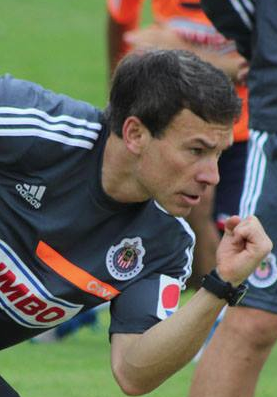
28 Jan Telluride WOW Fest’s Fabrocini: Posture, Stability, Mobility
During 2015, Telluride WOW popular presenter Bill Fabrocini, P.T. C.S.C.S. was working as a contributor on the “Younger Next Year: The Exercise Program,” a book by Chris Crowley and Henry S. Lodge M.D. that further explores the concepts of movement and stability to enhance body function as we age. And now, WOW! Just in time for the New Year, “Younger Next Year” is out. In addition, Bill recently sent this in-depth article about posture, stability and mobility. (WOW takes place Thursday, June 9 – Sunday, June 12, 2o16. Register here.)
Objectives:
• Define the importance of posture, stability, and mobility and explain how they relate to one another.
• Understand how posture, stability, and mobility independently and collectively effect movement.
Identify the bio-mechanical components of postural alignment and how it facilitates stability and mobility.
• Provide examples of how faulty posture, stability, and mobility adversely effect each other and influence body function and structure.
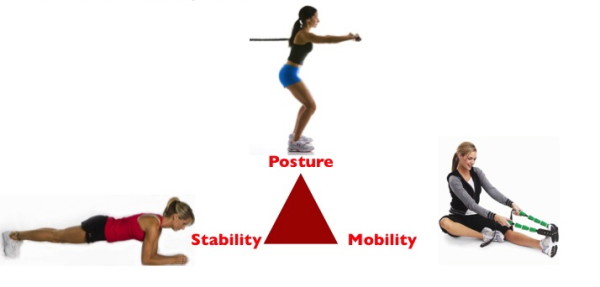
The Importance of Posture:
Let’s begin by exploring the significance and importance of posture.
Posture conjures many images in our minds. Perhaps most commonly is the one of our moms telling us to sit up straight which from an musculoskeletal perspective has much merit. When we sit up straight or stand tall “military posture” we align our joints in a manner that minimizes compressive joint forces and soft tissues loads (Saunders, 1985).
The “neutral spine” is the most typical term we hear to identify posture which is simply describing how we align our spine. In this position the center of gravity bisects our spinal curves which has several benefits and advantages (photo 1).
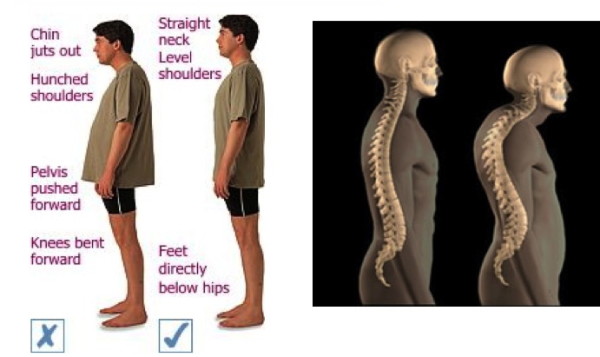
It is a stable and energy efficient alignment that requires the least amount of muscle contraction to support, it reduces shear and compressive loads on the spine, it provides the most optimal position for muscles to both support and move the spinal joints, and it establishes the ideal alignment for locomotion and other upright activities (McGill, 2002). The neutral spine is a perfect example of how posture dictates muscle function from a perspective of muscle fiber direction. When observing the lumbar components of the Erector Spinae (photo 2) in a neutral spine, these muscles are viewed to have an oblique angle of approximately 45 degrees from their origin on the sacrum to their respective vertebral attachments (McGill 2006).
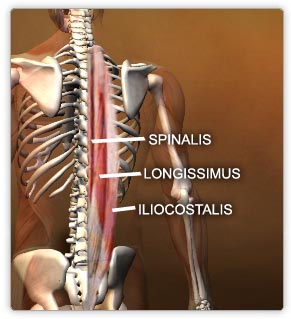
When the spine is flexed the muscle line of action changes to a more parallel alignment that results in a reduction in its ability to support the spine from damaging anterior shear forces that occur when lifting with a rounded spine (McGill 2006). The spinal curves directly influence the fiber direction of these back extensor muscles groups that are vital to control vertebral joint position and mitigate harmful forces on the spine. Hence, posture dictates the load bearing ability of the spine.
Posture is also relevant beyond the spine as the extremities too have a role. For example, the position of the ankles and knees can influence body alignment and impact force production (Starrrett 2013). Overpronation is a very good example that we see all too often in the sports medicine world, Overpronation in the lower extremities contributes to a variety of orthopedic overuse injuries such as achilles tendonitis, runners knee, patella tendonitis, etc. Applying this concept to posture we see that athletes who overpronate create an environment of excessive internal rotation and valgus that affects both knee and hip position (photo 3).
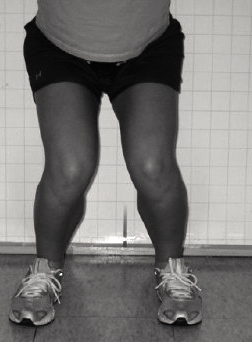
Postural faults as evidenced in this example of overpronation is not only static, but also dynamic. The position of one joint whether stationary or in motion directly impacts the joint position above and below. When athletes overpronate the knees tend to be more inclined to buckle inward compromising their ability to effectively shock absorb and control body weight as well as create force necessary for the propulsion phase of running. Its worth reiterating, posture dictates muscle function, and this applies not only to the spine but all of the joints including the lower extremity. When the ankles, knees and hips fall into poor alignment, the ability to produce force and support joint position is compromised (Starrett, 2013). Much like a car with poor shocks it is just a matter of time until something gives. The body joints must stack up well or posture is weakened and things break down. From this perspective it is easy to understand why posture should always be the foundation upon which we build movement skills.
Stability as a Concept:

Stability is the next concept worth breaking down into its most simple element.
I often am surprised how often this term is thrown around the fitness industry yet when we really try to define it we find vagueness in its meanings. I personally like to think of it from an architectural or structural engineering perspective in which it can simply be interchanged with the concept of “support.”
If you look at a suspension bridge, the support comes from the building foundation, the struts or beams, and the cables (photo 4). In comparison, if we look at the spine, the ligaments compare nicely to cables (photo 5), and the vertebrae stacked up on top of each other and sitting on the pelvis is the foundation ( photo 6) . The most significance difference in this analogy is that the spine, in addition to its passive support structures, is influenced by muscles that exert active forces upon its joints to impart tension and stiffness. These muscles are regulated by a finely tuned nervous system that sends and receives information from the spine ligaments and muscles to provide a stability framework that is highly advanced and capable of tremendous amounts of structural support (diagram 2).
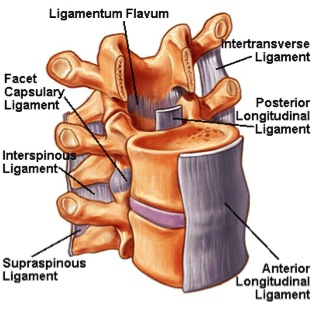
In this manner external forces across the joints of the spine can be balanced and adjusted to mitigate compressive loads and establish equilibrium (Morris 2006). This concept that entails the balance of forces to control joint alignment and position is perhaps the most accurate description of stability as it applies to the body.
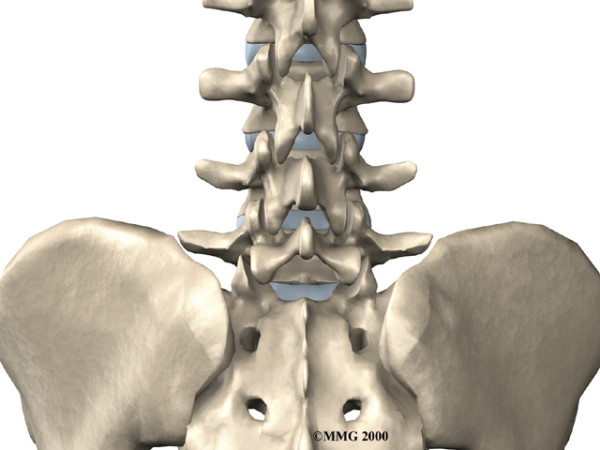
At this point I hope you can see the connection between posture and stability. When we assume good posture the joints of our body are aligned structurally to create stability. Our joints are stacked to provide optimal surface contact with tension on our ligaments equally balanced on all sides. The alignment of muscles is also ideal to both support and move the lever arms of our body. On the other end of the spectrum the stability components entail healthy ligaments that can withstand tensile forces to provide the skeletal system with the support it needs to maintain ideal posture both statically and dynamically in all planes of motion. A finely tuned nervous system also regulates muscular contractions on all sides of the joints of the body to further create the support necessary to maintain ideal posture. From this viewpoint it easy to understand why when posture breaks down so does stability and vise versa. The two are highly dependent upon one another to create an efficient structural and mechanical body movement system.
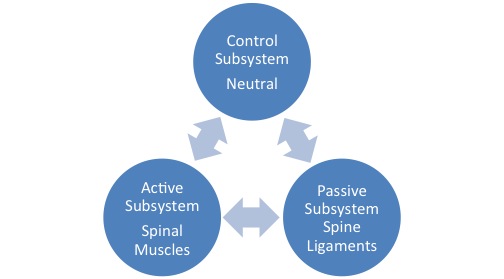
Mobility Bridging the Gap:
The last element of this triad and just as important and dependent on the others is mobility.
Mobility perhaps is the easiest element to define. Quite simply it is the ability to move freely. Soft tissue structures that have adaptively shortened and developed adhesions over time can restrict mobility and lead to dysfunctional movement. Typically the connective tissue of muscle, the fascia, and joint capsules all play a significant role (Starrett 2013). It is beyond the scope of this article to review the diagnostics and differentiating factors between these structures but we can appreciate that the source of any soft tissue restriction effects all the other structures and the overall quality of body movement. For example the hip capsule will impede the ability of the hip to extend if the anterior aspect has shortened and developed adhesions. The lack of hip extension over time will also effect the hip flexor muscles and anterior fascia fibers crossing the hip joint thereby reinforcing the limited hip extension. We must consider that limitations of mobility usual involve multiple soft tissue structures and that they must be addressed with a variety of soft tissue mobilization techniques and stretching strategies (Starrett 2013).
Perhaps even more importantly is to recognize the relationship that mobility has with posture and stability. In many cases we lose mobility in our joints and muscles because of poor posture that leads to a lack of stability and vise versa as already discussed. The expression “proximal stability equals distal mobility” is a two way street which also implies that “distal mobility equals proximal stability.”
If we have a stable core that can keep the spine still and in alignment, then distal joint mechanics are improved to maintain mobility through the hip and shoulder girldes. Vise versa, if we can keep our shoulders and hips fully mobile in all planes of motion, whether it be in daily life activities, exercise training, or sport, then we improve the ability to keep our spines stable and quiet.
Posture is the direct link to mobility and stability as we are most stable when we maintain good posture and we have more range of motion in our joints. Simply try to lift your arm over your head in a forward, slouched position as opposed to standing tall, shoulders back, head straight. Mobility is always greater when we take advantage of the natural postural alignment of the body.
Conclusion:
Posture, Stability, and Mobility provide for the blueprints of movement and are highly connected and dependent on one another. The foundation of all movement begins with posture and is applicable to both static and dynamic conditions. Postural alignment to move the body lever arms efficiently while mitigating loads on our joints and soft tissues can only be achieved when there is sufficient mobility and stability. Contrarily a body that lacks stability will default into poor posture that will inevitable have adverse effects on the body mobility structures.
More about Bill Fabrocini and Telluride WOW:
On its home page, Telluride WOW describes itself as a festival for EVERYONE,“ an event with a passion to change peoples’ lives through health and fitness – to inspire, motivate and educate.”
The workout weekend is designed to meet attendees where they are on their journey towards wellness, inside and out.
Does WOW succeed?
In the words of WOW 2015 top presenter Bill Fabrocini PT, CSCS, of The Aspen Club Sports Medicine Institute, the answer is a resounding “Yes.”
“Telluride WOW Festival is a one-of-a-kind event featuring some of the premiere professional presenters from the worlds of fitness, health, sports, and medicine,” explained Bill. “Having attended last year as a participant, I was very impressed with the variety of topics covered, lectures and exercise sessions alike. The weekend offers something for everyone regardless of where they are in terms of their own health and fitness goals and education level. I left the WOW filled with creative ideas I was able to integrate into my sports practices. Most importantly, I made many new friends and gained several opportunities for professional networking. I highly recommend attending WOW.”
Bill Fabrocini is a clinical specialist in orthopedic physical therapy and a sports performance training coach. He has worked at the Aspen Club Sports Medicine Institute in various capacities since 1990, at the same time running his own training and consulting business, Bill Fabrocini LLC.
During the course of a 25-plus year career, Bill has designed exercise programs for several prestigious institutions both in the private and public sector, including Mass General Hospital and The Aspen Ski Company.
He has also worked with a broad range of athletes including Olympic Medalists, NBA, NFL, and NHL athletes, the U.S. Ski Team, professional soccer players, Grand Slam Tennis and Golf Champions, professional ballet dancers, world-class runners, professional cyclists, soccer players, collegiate and high school athletes, corporate executives – and everyday individuals of all ages.
He also advises several youth organizations, including Team Prep U.S.A., which have produced numerous collegiate elite runners and Olympians.
Bill Fabrocini is creator of the exercise program featured in “Thinner This Year” by Chris Crowley and Jenniffer Sacheck Ph D. The book is the the sequel to the New York Times best-seller “Younger Next Year.” He also produced the accompanying DVD series that supplements the exercise portion of the book, “Thinner This Year: Preparation for Movement and The Sacred 25 and Beyond.”
And Now “Younger Next Year: The Exercise Program.”
Bill is also a frequent presenter at medical and fitness symposiums around the country and is the founder of the Aspen Sports Summit that will take place again Sept 9- 10, 2016.



Sorry, the comment form is closed at this time.